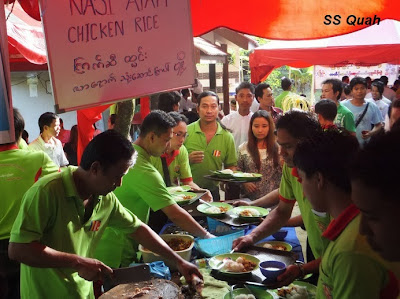Well, there we were again at the Buddhist Hermitage Lunas yesterday to participate in their annual Kathina festival. Kathina is the period that comes immediately after the end of the Buddhist Vassa, the three month-long rainy season retreat that is observed mainly by Theravadin Buddhist monks.
For us Chinese Malaysians, Kathina is quite typically a solemn and serious affair. The first order of the day upon arriving at the Hermitage would be the symbolic pinabaht ceremony, which was the offering of food to the monks. This was done through scooping rice into the monk's bowls.
Everybody then retreated to the main hall to await the start of the Kathina procession. The ringing of the temple bell at 9.30a.m. would denote the start of the walk and the procession, led by someone holding a small stone image of the Lord Buddha, then slowly wound its way around the grounds: going past the river and dining hall, the monks' kutis, round the pagoda and then beside the bhikkunis' quarters before ending back at the main hall.
Back at the main hall, there would be the offering of new robes to a row of visiting and resident monks. The ceremony would end with some chanting before the meals are served to both monks and devotees at the dining hall. These volunteers below were packing up the non-vegetarian meals.
For a long time, the Kathina ceremony at the Buddhist Hermitage Lunas had been a solemn occasion. But ever since the grand arch at the entrance was completed in 2008, the Burmese community have turned the Hermitage into their spiritual home-away-from-home and added their local touch to Kathina. It must be remembered that the Burmese workers around Penang and Kedah had contributed a lot of their time and effort in erecting this arch.
To the Burmese, Kathina is a time for great celebration and nowhere else in this particular spot of the country but here in Lunas was this more clearly seen.
When we arrived at the Hermitage yesterday, the open space in front of the kitchen had already been turned into a small carnival area. Yes, you read correctly. A carnival atmosphere. Tents had been set up and the Burmese were busily cooking away. Somewhere in the background, a small group were putting out the beats on their musical instruments. Except for one or two signs that betrayed the fact that this Hermitage was in the middle of semi-rural Malaysia, one would have thought that this rustic surrounds could be anywhere in Burma.
Fried beehoon, Burmese style
Burmese kerabu
Vegetable soup
Chicken rice, served the Burmese way
And then, there was Burmese laksa
Within the same area, the Burmese were also getting ready their Kathina trees or badaytha bin. I used to refer to them as money trees because they were decorated with currency notes. They still are, by the way, and the designs seemed to get more interesting with each passing year.
Meanwhile at the pagoda, various groups were milling around and taking photographs. All wearing their finest clothes befitting a grand occasion for celebrating.
And how did they celebrate Kathina? No, they did not participate in the Buddhist prayers at the main hall of the Hermitage. No, they did not join in the procession earlier. And no, they did not join in to offer any robes to the monks. At least, now while I was there, maybe they would do so later. I don't really know.
Then at about 11.45a.m., the Burmese started their own procession around the Hermitage grounds. Curious, I mingled in to see how they did it. Well, not vastly different from our own procession earlier except that, remember, they were in a carnival mood, complete with people playing their musical instruments. And one over-enthusiastic person dancing gangnam style to the beat.
So what do I think about this year's Kathina festival after seeing how we Malaysians observe it and the Burmese celebrating it too? Well, those are the two faces of Kathina. Ours is so solemn and serious; theirs is so light-hearted. But do not take their light-heartedness to mean they are anything less than devoted to Buddhism and the Lord Buddha. No, they are not, and friends who have been to Burma tell me the same. Indeed, I think the Burmese do know when to celebrate and be thankful for what they have.
And methinks we should also learn to lighten up and loosen up and regain some sense of humour. Religion should not always be straight and narrow. There is always room for flexibility and accommodation.



















No comments:
Post a Comment